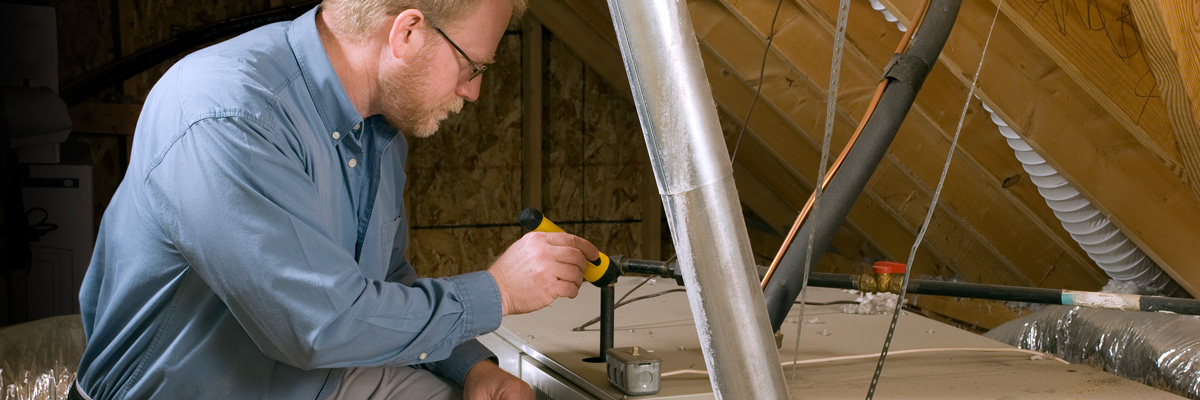
Duct test and repair rebate
Did you know that leaky ducts can add hundreds of dollars to your heating and cooling bills per year?* See how to seal in savings with a duct test and repair.
On this page:
Does your home have a room that is too hot in the summer or too cold in the winter? The culprit may be leaky ducts. In a typical home, about 20% of the air that moves through the duct system is lost because of improper installation.**
Our SRP Duct Test and Repair Rebate™ helps you identify places in your home where energy escapes. Our program covers 75% of repair costs or up to $400 of duct testing and qualified repairs.
What to expect from testing and repairs
For a typical home, testing can range from $100 to $450 and repairs often cost between $300 and $1,500. Houses and equipment can vary; therefore, actual costs may be higher or lower.
Your ductwork repairs include:
- Repair any major duct system issues, such as disconnected, crushed, restricted or poorly supported ductwork.
- Replace equipment door panel seals as needed, or seal equipment panels with UL-181 foil tape.
- Seal all electrical and refrigerant penetrations through equipment.
- Mechanically fasten and seal the connection between the air handler and plenums.
- Mechanically fasten and seal all supply and return plenum seams and end caps.
- Mechanically fasten and seal the connection between take-off collars and supply and return plenums.
- Mechanically fasten and seal the inner liner of all supply and return ducts to take-off collars.
- Mechanically fasten and seal all duct-to-duct connections, seams, sectioned metal elbows, branch T's, Y's and L’s.
- Mechanically fasten and seal inner liner of all supply and return ducts to supply boots and return boxes. The inner liner may be sealed from inside the living space.
- Insulate any exposed ductwork and replace any insulation removed or pulled aside.
- Ensure all supply boots are fastened to framing material with screws or roofing nails.
- Seal all gaps between the subfloor, wall or ceiling and the supply boots and return boxes.
- Seal all seams of each supply boot and each return box.
- Seal all panned returns and return air chases from lower floor walls to the attic.
- Seal all equipment platforms in closets or garages.
- Duct static readings are recorded both before and after any duct repairs.***
Get a duct test and repair rebate
Apply for your rebate in three easy steps:
- Find a contractor
. To qualify for the rebate, all tests and repairs must be completed by a BPI-certified contractor.
- Download this terms and conditions form
and have your contractor sign it. You’ll need to submit the signed form during the application process
- Complete the rebate application online
or download
it, complete it and send it by mail.
Online application checklist
Here’s what you’ll need to complete a Duct Test and Repair Rebate Application online:
- A paid-in-full itemized invoice and/or receipt, including:
- The installing contractor/company name, address and Arizona Registrar of Contractors (ROC) license number
- The date of service
- The address of service, including unit/apartment numbers
- The size of the system in tons (1–5 tons)
- The type of ductwork (flex or metal)
- The air handler location
- The duct leakage method and corresponding test-in and test-out results
- The signed contractor terms and conditions form (Download it here.
)
Program requirements
To participate in this rebate program you must:
- Be a permanent SRP residential electric customer with a central AC system or heat pump.
- REBATE MUST BE SUBMITTED WITHIN 6 MONTHS OF DUCT REPAIRS.
- Live in a single-family detached home, single-family attached dwelling or apartment/condominium.
- Single-family detached homes qualify for up to a $400 rebate.
- Mobile homes, manufactured homes, apartments, condominiums and townhouses qualify for up to a $300 rebate.
- New construction homes and evaporative coolers are not eligible.
- Complete duct test and make qualified repairs through a participating Duct Test and Repair contractor
by April 30, 2026.
- Allow SRP or our agent to inspect repairs, upon request, to verify compliance with all rebate requirements.
The State of Arizona offers a Weatherization Assistance Program (WAP) available for households with lower incomes that qualify for Supplemental Security Income, Aid to Families with Dependent Children, and other income eligibility criteria. This program includes a home energy assessment and common home improvements such as testing, tuning, and maintaining cooling and heating equipment. In some cases, cooling and heating equipment may be replaced with new equipment. Please see the link
for additional information.


